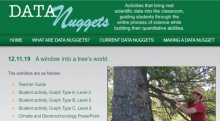You are here
Climate Teaching Tool Co-Produced by Local Teacher & HF Scientist

A new teaching tool for middle, high school, and university classrooms guides students in using Harvard Forest tree-ring data to answer questions about local climate change. The lesson plan was produced by Elicia Andrews, a teacher at Quabbin Regional High School in Barre, MA, who also participates in the Harvard Forest Schoolyard Ecology Program. Andrews was supported in summer 2019 by a grant from the National Science Foundation to complete a "Research Experience for Teachers" (RET) at Harvard Forest, as part of its Long-Term Ecological Research Program.
During her 7-week RET experience, Andrews conducted field- and lab-work in the Harvard Forest Tree Ring Lab with Senior Ecologist Neil Pederson, Research Assistant Tessa Mandra, and several undergraduates from the HF Summer Research Program. After learning to core trees and analyze tree rings via a cross-dating method, Andrews turned to drafting the educational Data Nugget, for which Andrews worked closely with the science team and with HF Schoolyard Ecology Coordinator Pamela Snow and Director of Education Clarisse Hart.
The final product is a publicly available lesson plan that allows students to graph and interpret real scientific data to evaluate how the growth of Atlantic White Cedar - a species at the edge of its climate range in Massachusetts - is responding to long-term changes in climate.
- Explore/download the Forest's tree-ring Data Nugget
- Learn more about the Harvard Forest Tree Ring Lab
- Learn more about the Harvard Forest Schoolyard Ecology Program, which engages more than 4,000 students each year
- Explore the Forest's carbon eddy-flux Data Nugget

